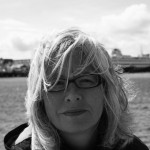Transversing Trails and Frontiers by Star Rush
A little more than 2 years ago, I started splitting my time between Seattle and rural Pacific County, about 150 miles southwest of the city. The county is one of Washington state’s oldest, having been founded by the government of Oregon Territory in 1851. The geography is marked dramatically by the Columbia River as it empties into the Pacific Ocean.

The landscape is characterized by expansive natural resources, historic drama and layers of memory. Here, Lewis & Clark Expedition cited the Pacific Ocean for the first time in 1805 and found what they sought when they left St. Louis the year before. The party had been hunkered down along the Columbia River for weeks in what is now named “Dismal Nitch.” These days, it is ironically a rest stop along Highway 4 with a heritage marker and picturesque views of Astoria, Oregon, and Megler Bridge. A mile west is Middle Village Station Camp, ancestral home of the Chinook people, who have lived and traded along the Columbia for thousands of years. When the Expedition arrived, Clark used the area as his survey station, mapping the river’s mouth. More than 20,000 people live in Pacific County today. Throughout the county are communities preserving the cultural and ethnic heritages of emigrants from Sweden, Denmark, Switzerland, Norway, and Finland as well as the ancestors of the Chinook people, who live in the towns of Bay Center, Chinook, and Ilwalco.

Military forts remain as ruins, remnants of a former purpose: to guard the strategic mouth of the Columbia from the late 1800s to their closing after World War II. The forts are now state parks, popular with visitors camping, site seeing, and enjoying the outdoor recreation. Gun stations stand still. All that’s left of bunkers are concrete outlines of their foundations, lookouts giving expansive views of the Columbia and what are now suburban shopping centers, open fields, and campgrounds.
Towns in this county include its largest, Raymond, its county seat, South Bend, and a number of smaller ones whose economies had thrived upon the natural resources of timber and fisheries at one time-and now-tourism and recreation. Their historic downtowns are weathered, the old Sears & Roebuck sign on a brick building slowly disappearing. Willapa Bay, an estuary separated from the Pacific Ocean by the Long Beach Peninsula, is known for its biodiversity and is a working bay, supporting a local oyster and seafood industry. Here, oyster men and women grow nearly 9% of all oysters in the U.S. The estuary and rivers are habit to a diverse ecosystem of woodland, grassland, and coastal plants and animals.




Photographing in this geographic and cultural landscape has me navigating new terrain, not just in terms of land- and seascapes, but those of my imagination. I’m interested in memory as performative flux and renewal. I’m curious about the juxtaposition of civc history markers of Manifest Destiny and its products of economic prosperity and growth, cultural appropriation and annexation, territorial occupancy, and annihilation of indigenous peoples. Remnants remain of a time when robust commerce and industry fostered thriving economies and also environmental exploitation across this expansive-and still present-ecological grandeur. The “thens” and “nows” blur among artifacts of natural and built landscapes, of found and constructed objects that leak both an imagined and real cultural and social legacy. These are disjunctive narratives that transpose cultural tropes against a complex socio-historic landscape.





Hills roll above the Willapa River. They can look haggard and depleted as timber sales lay them bare. Clear cuts regularly scar the route on Highway 101 from Olympia toward the Pacific Ocean. Along any stretch of the highway, my car window frames gothic Sitka Spruces and Bald Eagles. Around the bend, trees have been amputated to splintered stumps and strewn limbs, the land ravaged as hawks circle above. In summer, a stream of campers, motor homes with names like, “Prowler”, “Bullet”, “Elite”, or “Expedition” and trucks pulling boats make their way west to the Pacific Ocean. They’ll drive by Middle Village, Dismal Nitch and Cape Disappointment to beachfront boardwalks, salt water taffy, ice-cream and bright windsocks all along the sunny holiday shore.




Photos captured with iPhone 5 between 2012 – 2014
 Star Rush is a photographer, writer, and educator, whose background is in journalism, marketing, composition and rhetoric, and poetry.
Star Rush is a photographer, writer, and educator, whose background is in journalism, marketing, composition and rhetoric, and poetry.
Her mobile photography has been exhibited in the United States, London, and Europe and published in magazines Actual Colors May Vary, Askar Magazine, Camerapixo, dodho.com, as well as Resource Magazine, wiete.it, and Volksrant. Her writing about connected mobile photography has appeared in iPhoneography.com, wearejuxt.com, dprConnect, EyeEm.com, iPhoneogenic.com, and others.
She has been faculty and educational administer in higher education, teaching and writing, and currently serves as Special Assistant for Teaching & Learning at Cornish College of the Arts in Seattle.
Work and contact information: starrush.net.
About Author

Latest stories
 CommunityDecember 31, 2020We Bid Adieu
CommunityDecember 31, 2020We Bid Adieu Alexandra PrestonDecember 31, 2018December Wishes from Grryo
Alexandra PrestonDecember 31, 2018December Wishes from Grryo StoriesMarch 11, 2018The Marigoldroadblog Project by Adjoa Wiredu
StoriesMarch 11, 2018The Marigoldroadblog Project by Adjoa Wiredu Antonia BaedtDecember 22, 2017‘Tis a Jolly Grryo Christmas
Antonia BaedtDecember 22, 2017‘Tis a Jolly Grryo Christmas


I have fun with, lead to I discovered just what I used to be taking a look for.
You have ended my 4 day lengthy hunt! God Bless you man. Have a nice
day. Bye